Jamie Todd Rubin's Blog, page 4
March 30, 2025
Shelf-Life #7: Did I Ever Tell You How Lucky You Are?
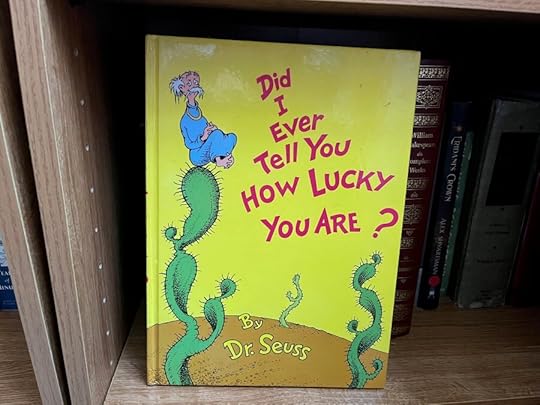
This post is part of my weekly series, Shelf-Life. Each episode is about a particular book on my bookshelves. For more information see my introductory post. To read other episodes in this series, see the Shelf-Life Index page.
What is the first book you remember? Pressed to answer this question, eyes traversing the tall silhouettes, pillars of the shelves in my office, thoughts spelunking into the increasingly shadowy regions of my early memory, I’d have to say that the first book I remember is Dr. Seuss’s Did I Ever Tell You How Lucky You Are? The book was published in 1973 when I was just a year old, but its warm, yellow cover, red-lettered title, and mustachioed guru perched upon a cactus are as familiar to me today as anything, and while this certainly isn’t the first book that was read to me, it is the one that stands out in my consciousness as the first I remember. It is no coincidence, therefore, that it was and remains to this day, my favorite of Dr. Seuss’s books.
My dad read me Dr. Seuss books before I could read on my own. My earliest literary memory is that of the poetic rhythms of Dr. Seuss, spoken with my dad’s unique inflections, many of which I retained when reading these books to my own kids when they were young. If we didn’t go through the entire Seuss oeuvre, we missed only a few. And though I couldn’t yet read when these stories were read to me, I could and did memorize them. Family lore has it (and personal memory recalls) reciting one of Dr. Seuss’s stories, “What Was I Scared Of?1” to any available audience. I’m not sure why this was considered impressive: hear a story read aloud enough times and one can’t help but memorize them. But there I was standing before various adults, volubly reciting from memory (even now as I type this):
Well… I was walking in the nightAnd I saw nothing scary.
For I have never been afraid
Of anything. Not very.
I loved listening to my dad read these books to me. He read them all, over and over again. The ones that stand out are books like The Lorax and Happy Birthday To You! and Scrambled Eggs Super! (de-duper-de-booper, special deluxe, a la Peter T. Hooper). But I also recall enjoying books like Thidwick, The Big-Hearted Moose, Horton Hears a Who, If I Ran the Zoo and On Beyond Zebra. At one point, I probably had all these books memorized, and I was greatly relieved when I finally learned to read and realized I didn’t need to rely on my memory any longer to enjoy the books.
And yet, half a century later, I still know “What Was I Scared Of?” by heart. I still know The Lorax by heart. And I can still recite, in its entirety, Did I Ever Tell You How Lucky You Are? from memory, including my dad’s subtle cadence, and a few of my own that I’ve added over the years.
But why is Did I Ever Tell You How Lucky You Are? my favorite? For those unfamiliar with the book, it tells the story of Duckie who meets a wise man in a desert who tells him:
When you think things are bad,When you feel sour and blue,
When you start to get mad…
You should do what I do!
Just tell yourself, Duckie,
You’re really quite lucky!
Some people are much more…
Oh, ever so much more…
Oh, muchly much-much more
Unlucky than you!
Our host then parades Duckie past a score of people in increasingly unfortunate and unenviable situations. In one such situation, Duckie is posed with the dilemma of living in the city of Ga-Zair. There is a picture of the Seussian city spread across two pages, and I can still see my dad pointing to the top left corner of the left page, and reading, “With your bedroom up here…” and then tracing the elaborate and precarious staircases through the city to the top right of the right page, and continuing, “…and your bathroom up there.”
My bathroom was just a few steps down the hallway from my bedroom and I distinctly recall being suddenly grateful for this fact.
If you look closely at the photo of the book above, you’ll see that “Seuss” is not far from “Shakespeare” on my shelves. Both wrote in verse, and both wrote about human nature. But I encountered Dr. Seuss before William Shakespeare, and while there is much about Shakespeare that I admire, my heart is with Dr. Seuss.
For as long as I can recall, I’ve always felt the need to draw practical lessons from reading. I read for the entertainment, and to learn new things, but regardless of what I am reading, I am always on the lookout for the practical lessons. Not only that, I try to apply those lessons to my life. It may very well be that I drew my first practical lessons from Did I Ever Tell You How Lucky You Are?.
I drew from this book my first awareness of the rhythm of language. I’d heard songs on the radio, of course, and there were other books written in rhyme. But it was with this book that I first realized that music wasn’t necessary for rhythm, that words, well written, could have a rhythm all their own. There was a playfulness to the rhythms that I don’t recall from other books. Part of that might have been due to the way my dad read the book, but even that was a lesson: there was a rhythm to language beyond the page, it was something that the reader brought to the mix.
It was also not hard for me to imagine how much more difficult life might be if I didn’t have a conveniently located bathroom. Over time, this morphed into a mental reminder to myself that as bad as things might seem, there are those who have it far worse than I do.This learned lesson is no more clear to me than in 29 years of diaries. Scattered through those years are dozens of entries that seem to take a pause from the day-to-day hustle and bustle to review where life has taken me, and how lucky I have been. Or, on the flip side, when something has gone badly, to try to find the good that comes from it, and remind myself that some people are much more, oh, ever so much more, muchly much-much more unlucky than me.
The story appears in The Sneetches and Other Stories . For the longest time, I thought the story was called “The Pale Green Pants” because, well, a pair of pale green pants is one of the two characters in the story. ︎
︎Did you enjoy this post?
If so, consider subscribing to the blog using the form below or clicking on the button below to follow the blog. And consider telling a friend about it. Already a reader or subscriber to the blog? Thanks for reading!
March 25, 2025
Shower Brain
While reading an article on “The Wonder of Insight” by John Kounios and Yvette Koumios in the March 2025 issue of Scientific American, I came across the following passage:
In the 2010s Brian Erickson, then a doctoral student in John’s laboratory at Drexel University, and his colleagues demonstrated that people’s tendency toward insightful or analytical thinking is evident during “resting-state” brain activity–while a person relaxes with no task to perform or expectation about what is to come.
I recognized this “resting state” brain activity at once. I call it “shower brain” because it happens most frequently to me when I am in the shower. There is something a little depressing that the only time I relax with no task or expectation is when I am in the shower. But that’s how it is. I knew that I had good ideas more frequently in the shower than in other places. But until I read that passage, I didn’t realize it was because my brain was in a rare idle state.
Years ago, the elliptical must have served a similar purpose. I’d start my workout, and my brain would go into an idle state. One time, I had started writing a story called “Take One for the Road” and became stuck on point. On the elliptical machine, while my brain was idle, I had the solution all at once. I went from elliptical to word processor, skipping the shower, so that I could get my solution written before I forgot it. “Take One for the Road” became my third professional story sale, and the first one I made to Analog.
Stories abound in the history of science of these eureka moments. Leo Szilard was crossing a street in London in the early 1930s when he suddenly saw that a nuclear chain reaction was possible. Many of the founders of modern quantum theory had similar moments. I’ve heard writers speaking of stories forming completely in their heads so that all they had to do was take dictation from their muse.
I don’t take advantage of the shower enough in this regard, which is surprising given how effective it frequently is. On one software project for my day job, I had a fairly complex construction, and one morning, unbidden in the shower, came up with a much simpler (and more elegant) solution. Story ideas come unstuck in the shower. New ideas for blog posts grow better there than anywhere else. One would think that all I need do when I hit a tough problem is to stop what I’m doing and head to the shower. But I don’t.
In decades past, going to the movies served a similar purpose. In the late 1990s, when I was stuck on something, I’d head to the movies to see some action film that didn’t require a lot of thought, and that I could easily get lost in. I usually emerged from the movie theaters entertained and enlightened, the problem solved in the background as the film unspooled on the screen.
The Scientific American article pointed to the parts of the brain where insights take place, and experiments had revealed some of the circumstances leading up to these light bulb moments. An occasional idle brain seems to be a partial pre-requisite. It’s amazing to me how rare an idle brain—“shower brain”—is for me. My mind is constantly racing, constantly processing input. I joke that my default “idle” is reading. But the article seems to argue for idle time for its own sake, for its potential insights.
The problem is, the moment I am not doing anything, I feel lazy. Thus, my penchant for very fast showers.
Did you enjoy this post?
If so, consider subscribing to the blog using the form below or clicking on the button below to follow the blog. And consider telling a friend about it. Already a reader or subscriber to the blog? Thanks for reading!
March 23, 2025
Shelf Life #6: Salem’s Lot
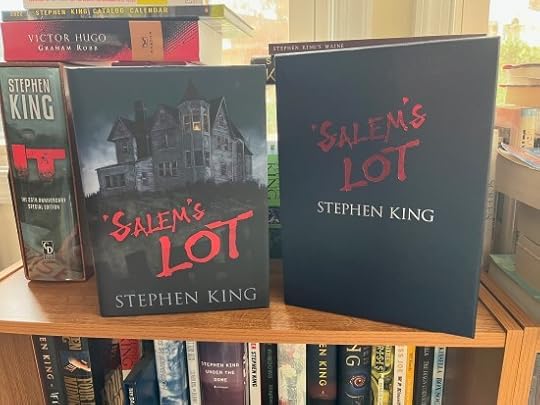
Where were you when Neil Armstrong and Buzz Aldrin set foot on the moon? When John F. Kennedy was assassinated? When the first plane hit the World Trade Center? We have a knack for recalling our circumstances during world-shaking events. For me, I remember what I was reading.
Perhaps it is simply a weird trick of memory, but I can look at just about any book on the list of books I’ve read since 1996 and recall in great detail where I was when I read the book. I can’t explain how I do this, but because of this trick, I know that I was on a plane to Los Angeles from Lihue, Hawaii, when I cracked open Stephen King’s Salem’s Lot and started to read it on September 8, 2001. I was still reading the book three days later when terrorists struck, and the towers came down.
In a rare burst of snobbery, I’d resisted reading a Stephen King book, telling myself, completely irrationally, that someone so popular couldn’t be very good. It took three of his books to completely change my mind.
In that first reading of Salem’s Lot, I was impressed by the depth and realism of the town and its inhabitants, despite the supernatural element. King populated his town with interesting people and put them in an interesting situation and then sat back to see what happened. Later, I’d learn this was what made his stories so compelling (for me, anyway). What bothered me on that first read was that the ending didn’t quite seem to pay for all the work that came before it. This is probably a familiar criticism to King fans, but I think it is one of perspective.
That first reading started out as a break for denser reading I’d been doing. Before Salem’s Lot, I was sitting poolside at a resort in Princeville, Hawaii, reading The Fed: The Inside Story of How the World’s Most Powerful Financial Institution Drives the Markets by Martin Mayer. And before that, I’d tackled Eisenhower: Soldier and President by Stephen Ambrose. Just because I am on vacation doesn’t mean my reading goes on vacation. But I was ready for a break, and something lighter and more entertaining, and I decided to give Stephen King a try. With 9/11, the book became an escape for me. I’d say I enjoyed three-quarters of the book, but my joy was dampened by world events.
It was almost three years before I read another Stephen King book. In the fall of 2004, I read Needful Things. Once again, I was astonished by King’s ability to create town and populate it was all kinds of interesting people—interesting enough to keep me reading for almost 800 pages! And once again, I thought the “explosive” ending didn’t live up to the build-up.
There is a certain combination of craftsmanship and hard work that I deeply admire. Genius is something genetic. Genius, when properly applied, can result in outstanding insights in science, and amazing works of literature, and stunning works of art. In my experience, however, it is possible for those of us who are not geniuses1 to achieve similar results through greater effort, an effort involving a dedication to craftsmanship and hard work. In 2009, when I first read Stephen King’s On Writing: A Memoir of the Craft, I saw that illustrated clearly.
Set aside whether you think Stephen King is a genius as a storyteller; his dedication to craft and the hard work he puts into it—detailed in his writing memoir–achieve same results. The book also made me realize that King takes his work seriously. He is not churning out books to pay the bills. After the paperback rights to his first novel Carrie were sold, money was no longer a factor. Each book is unique and tries to do something unique. Then, too, a careful reading can uncover an entire meta-work, that touches on nearly everything King has written.
I came away from that first reading of On Writing with a desire to try reading King again, this time starting from the beginning. I went on to read, in rapid succession, Carrie, The Shining and It. That last, It, took King’s work to a whole new level for me. It quickly jumped to the top of my favorite novels of all time. I continued on with Night Shift, Under the Dome, and Different Seasons, the latter of which shows King’s versatility outside the horror genre, to say nothing of his ability to write short fiction on par with his novels.
By the next time I read Salem’s Lot, in 2013 some dozen years after my first time, my entire perspective had changed. I read it more carefully and enjoyed it more thoroughly than ever before. When I finished, I realized that what bothered me about the end of the book was not so much that it didn’t live up to the buildup, but that there seemed to be so much more to the story. Later that same year, I discovered, to my surprise, that I was right. There was more to the story, and I found more when reading King’s Dark Tower series.
In the fifth book of the series, Wolves of the Calla, Father Callahan, formerly of Salem’s Lot, had slipped into Mid-World and had been living among a small community of people. In that book, Roland and his ka-tet, and this reader, learned the rest of the story of Salem’s Lot from Callahan himself.
I’ve read Salem’s Lot four times now, each time enjoying more than the time before. It changed the way I look at reading. It provided me with a humbling moment and reminded me not to judge a book (or an author) by its metaphorical cover. Just because a writer is popular does not necessarily diminish their work because it appeals to the masses. Indeed, a popular writer may be successful because, like a popular baseball player, they have worked for years (decades sometimes) to master their craft and delivery something superb each time they come to the plate—or at the keyboard. My experience with Salem’s Lot taught me to approach any book with an open mind.
My first read of Salem’s Lot was the 209th book I’d read since I started keeping my list in 1996. Since that book, I’ve read 1,221 additional books, each one of them selected with an open mind. I owe a debt of gratitude to both Stephen King and Salem’s Lot. I shudder at the thought of how different (or diminished) my reading list might look had it not been for this lesson.
Did you enjoy this post?
If so, consider subscribing to the blog using the form below or clicking on the button below to follow the blog. And consider telling a friend about it. Already a reader or subscriber to the blog? Thanks for reading!
 ︎
︎
March 19, 2025
Moonlight Becomes You
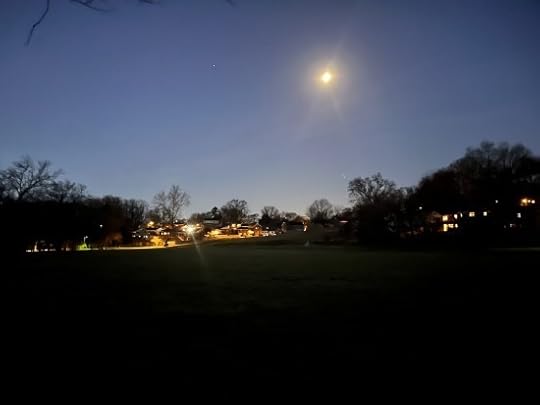 Moonlight over the local park this morning.
Moonlight over the local park this morning.Selfishly, I wish we’d do away with Daylight Saving Time. As an early riser, who heads out for a 2-1/2 mile walk first thing each morning, I prefer walks in the half hour before sunrise. Each spring forward hurtles me back into morning darkness for my walks. I take a light with me that I occasionally use, but I much prefer the natural light from the brightening eastern sky.
In my neck of the woods, the earliest sunrise comes in June, which has an average sunrise at 5:43am. The skies start to brighten half an hour before that, meaning I can see light in the eastern sky not long after 4am. My sleep schedule tends to follow the sun for a good part of the year so that in the summer, I wake up around 5am and head out for my walk not long after. The latest sunrise comes in January, averaging 7:23am, and meaning first light just before 7am. I’m an early riser and can’t sleep in that late, so I am usually up just before 6am in the winter months, and I head out in darkness.
Every once in a while, however, my dark morning walk coincides with a full moon that hangs high in the southwestern sky, and I find I have a natural nightlight to illuminate the path. Moonlight is a softer light and it creates softer shadows. Passing deer on the path in moonlight silhouettes them, and the moonlight gleams in their dark eyes.
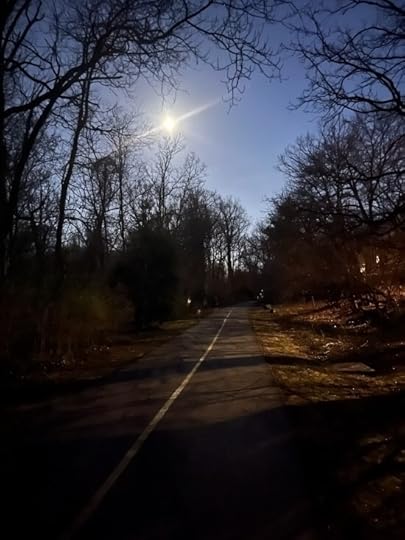 Moonlight illuminating the path on my walk this morning.
Moonlight illuminating the path on my walk this morning.I’ve had such a moon the last few mornings. The moon wasn’t quite full this morning, but it was perfectly positioned to provide a soft glow for most of my walk, so that I didn’t need my artificial light.
I’m not a fan of Daylight Saving Time, but on mornings like these, it doesn’t bother me quite as much.
Did you enjoy this post?
If so, consider subscribing to the blog using the form below or clicking on the button below to follow the blog. And consider telling a friend about it. Already a reader or subscriber to the blog? Thanks for reading!
March 16, 2025
Shelf-Life #5: A Man on the Moon
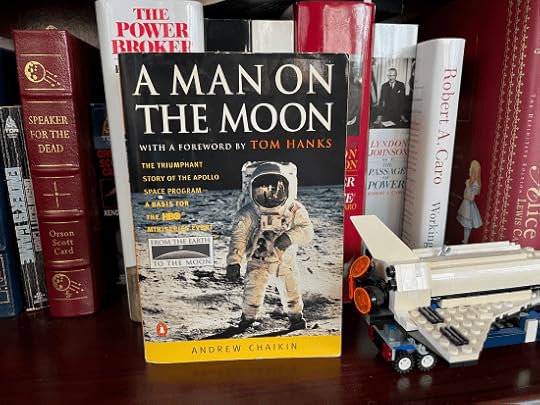
Some books are a call to action. Such was Andrew Chaikin’s A Man on the Moon. This book set me off on two paths of discovery: one on the U.S. space program before the space shuttle era; the other was one to see if I could be part of that program.
It started with the HBO miniseries From the Earth to the Moon which debuted in the spring of 1998. I didn’t have cable, but my folks did. My dad would record the episodes for me, and I’d drive over to their house to pick it up every week or so and return home and watch them. I watched the first two episodes on April 9, 1998, and that evening, wrote in my diary, “Watched From the Earth to the Moon and the first two episodes were great! Can’t wait for the next ones.”
Less than a month later, on May 1, 1998, I wrote the following in my diary:
I think that I decided that I want to be an astronaut today. I know that sounds odd, especially since I’m already 26 years old and “grown up1.” But I was browsing some of NASA’s web today and found their astronaut candidate program pages. I know that I don’t have a chance in hell to qualify. And I’m not kidding myself. It was only a daydream… I certainly may not make it. But think of what I can do for myself trying. I can put myself into outstanding mental and physical condition. I can try to learn new things with a real heroicgoal in mind. And as long as I remain realistic from the start (my chances are extraordinarily slim) I can’t lose. I’ll come out a far better person than I went in, no matter what.
The reason I was on the NASA website was almost certainly inspired by the HBO miniseries. At some point, watching the credits of the series, I discovered that it was based on a book by Andrew Chaikin. A few days after I decided I wanted to be an astronaut I,
went to a bookstore and I bought a copy of A Man on the Moon by Andrew Chaikin. This is the book that From the Earth to the Moon is based on. It’s nearly 700 pages and I got through about 30 pages…
The next day, I blew through 100 pages of the book. I was reading NASA manuals and guidelines for becoming an astronaut candidate all the while. I realized several things: (1) most astronauts had some kind of science or engineering background. I did not, but I would worry about that later; (2) most astronauts were athletes of some kind or another, or at least in great physical condition. That was something I could start to improve in myself; (3) many of the astronauts had logged thousands of hours in a variety of aircraft. I’d wanted to be a pilot since I was 8 or 9 years old. Maybe now was the time?
I started to run with my friend Jim as a way of getting into better shape. I was 26 years old at the time. Jim was 39. He ran circles around me, but we kept it up, running up the park above the beach in Santa Monica on Tuesdays and Thursdays after work.
A Man on the Moon started me on the road of a whole bunch of books of the U.S. space program. Immediately after finishing the book, I read two more: Deke! by Deke Slayton and Carrying the Fire by Michael Collins. That book is probably the single best astronaut memoir I’ve ever read.
Those books led to others: Failure Is Not an Option by Gene Kranz; Moon Lander: How We Developed the Apollo Lunar Module by Tom Kelly (one of the best practical project management books I’ve ever read, right there along with The Making of the Atomic Bomb); Flight: My Life In Mission Control by Chris Kraft; John Glenn: A Memoir2.
I never did become an astronaut, but like I wrote when I first decided I wanted to be an astronaut, I came out a better person because of my efforts. For one thing, it was during this time that some of my self-discipline improved. I was generally a late sleeper, but I became an early riser during this time, something I continue to this day. The experience taught me how to set better, more manageable goals, which was important in both the short term and the long term. I might not have made it as an astronaut, but I still wanted to be a pilot, and so I set that as an interim goal. My diary entry for July 14, 1999, starts: “I went on my first official flight as a student pilot today and logged 0.8 hours of dual time…”
Nine months later, on April 3, 2000, my diary for the day started as follows:
8:55am – Here goes nothing!
9:00pm – Here comes something! Jamie Rubin, Private Pilot, Single Engine Land! I passed my check ride today…
Becoming a pilot demonstrated my ability to multitask more than I was ever aware I was capable of. It taught me about situational awareness. And it taught me to keep cool in tough situations, analyze the situation, and avoid making things worse.
My fascination with the U.S. space program never diminished. Over the years, I accumulated more books and read as much as I could about the space program. I read Light This Candle: The Life and Times of Alan Shepard by Neal Thompson and Rocketman: Astronaut Pete Conrad’s Incredible Ride to the Moon and Beyond by Nancy Conrad. Conrad was the commander of Apollo 12, which was my personal favorite lunar mission and crew3. I read First Man: The Life of Neil Armstrong by James R. Hansen on a plane home from Hawaii.
Much later I started reading more of the detailed history of the space program: Go Flight: The Unsung Heroes of Mission Control, 1965-1992 by Rick Houston and Milt Heflin; Into that Silent Sea: Trailblazers of the Space Era, 1961-1965 by Francis French and Colin Burgess; In the Shadow of the Moon: A Challenging Journey to Tranquility, 1965-1969 by Francis French and Colin Burgess; Footprints in the Dust: The Epic Voyages of Apollo, 1969-1975 by Colin Burgess; Bold They Rise: The Space Shuttle Early Years, 1972-1986by David Hitt and Heather R. Smith; and Wheels Stop: The Tragedies and Triumphs of the Space Shuttle Program, 1986-2011 by Rick Houston.
Any time I discovered a new book on the space program, I devoured it. I read Rocket Men: The Daring Odyssey of Apollo 8 and the Astronauts Who Made Man’s First Journey to the Moon by Robert Kurson. I read about the Voyage Missions in The Interstellar Age: Inside the Forty-Year Voyage Mission by Jim Bell. I read Tom Wolfe’s The Right Stuff, decades after I saw the movie4. I read Douglas Brinkley’s American Moonshot: John F. Kennedy and the Great Space Race and One Giant Leap: The Impossible Mission That Flew Us to the Moon by Charles Fishman. I even read about life in mission control with Safely to the Earth: The Men and Women Who Brought the Astronauts Home by Jack Clemons. I finally got around to reading the classic history of Apollo, Chariots for Apollo: The NASA History of Manned Lunar Spaceflight to 1969 by Courtney G. Brooks, James M. Grimwood, and Loyd S. Swenson, Jr. I read Into the Black: The Extraordinary Untold Story of the First Flight of the Space Shuttle Columbia and the Astronauts Who Flew Her by Rowland White. And I read the fantastic biography of George M. Low, The Ultimate Engineer by Richard Jurek.
I haven’t stopped reading about the space program. Indeed, at present I am reading SUNBURST and LUMINARY: An Apollo Memoir by Don Eyles, the man who wrote the computer code for the Apollo guidance system. I’ve read so much about the space program that in some ways, it feels like I’ve been in orbit, watching the Earth roll silently by; it feels like I’ve stood in the Ocean of Storms, goofing around with Pete Conrad and Al Bean.
When I was a wee youngster, my mom told me that books can take you anywhere. She was right.
Did you enjoy this post?
If so, consider subscribing to the blog using the form below or clicking on the button below to follow the blog. And consider telling a friend about it. Already a reader or subscriber to the blog? Thanks for reading!
 ︎I listened assiduously to his mission on the space shuttle, when, at the time, he became the oldest person to go into space. After I read his memoir, I wrote Senator Glenn a letter, and I got a very nice reply from him.
︎I listened assiduously to his mission on the space shuttle, when, at the time, he became the oldest person to go into space. After I read his memoir, I wrote Senator Glenn a letter, and I got a very nice reply from him.  ︎After Apollo 11, the pressure was off. Conrad, Alan Bean, and Dick Gordon were a fun crew and seemed to have fun throughout their mission, despite their Saturn V rocket being hit by lightning twice after lifting from the launchpad.
︎After Apollo 11, the pressure was off. Conrad, Alan Bean, and Dick Gordon were a fun crew and seemed to have fun throughout their mission, despite their Saturn V rocket being hit by lightning twice after lifting from the launchpad.  ︎In the 1980s, The Right Stuff was my favorite movie for a long time.
︎In the 1980s, The Right Stuff was my favorite movie for a long time.  ︎
︎
March 13, 2025
Future Reading, March 2025 Edition
I’m back from another recent jaunt to the future to scout out interesting books that will be hitting the shelves. One of the more exciting books that I’ve mentioned elsewhere is a new posthumous collection of essays by the late David McCullough called History Matters.
I was delighted to see that Simon Winchester has a new book coming out, The Breath of the Gods: The History and Future of Wind. I always enjoy his books. There’s a bit of a wait on this one as it doesn’t drop until mid-November.
I’ve also enjoyed many of Alan Lightman’s books, and so it was nice to see a new book coming, cowritten with Martin Rees, The Shape of Wonder: How Scientists Think, Work, and Live. This one also debuts in mid-November.
Richard Russo has a new collection of essays, Life and Art, coming in May. And Tim Berners-Lee, inventor of the World Wide Web, has a memoir arriving in September, This Is For Everyone: The Unfinished Story of the World Wide Web.
A couple of novels I’m looking forward to are on the horizon: Return to Sender, the latest Walt Longmire novel by Craig Johnson, and Never Flinch, another novel featuring Holly Gibney by Stephen King. Both drop on the same day, May 27, 2025.
There’s a biography of John Hancock by Willard Sterne Randall coming in June, and a biography of Mark Twain by Ron Chernow coming in November.
I recently wrote about art that moves me, and on my jaunt, discovered a book that describes mathematics in artful terms, Love and Math: The Heart of Hidden Reality by Edward Frenkel. In this case, the book isn’t new, but the audio edition is. This one comes out in September. And while I’ve read plenty of books on the Apollo space program, I don’t think I’ve read one specifically about the Gemini program. That will be remedied in November with Gemini: Stepping Stone to the Moon–The Untold Story by Jeffrey Kluger.
Those are a few of the notable books I saw, and I’m looking forward to all of them. Some don’t come out for quite some time. Fortunately, I’ve got plenty to occupy me in the meantime. At present I’m re-reading one of my favorites, The Making of the Atomic Bomb by Richard Rhodes (a recent entry in my Shelf-Life series). It has me deeply interested in the scientists who formulated quantum theory. I’ve got three additional books to pursue on the subject: Quantum: Einstein, Bohr and the Great Debate About the Nature of Reality by Manjit Kumar; Too Big for a Single Mind: How the Greatest Generation of Physicists Uncovered the Quantum World by Tobias Hürter; and Genius in the Shadows: A Biography of Leo Szilard, the Man Behind the Bombby William Lanouette (with Bela Silard).
Then, of course there is the current book club book, There Are Rivers in the Sky by Elif Shafak, to say nothing of the growing stack of nightstand books I’m making my way through, which range from sports writing to systems engineering.
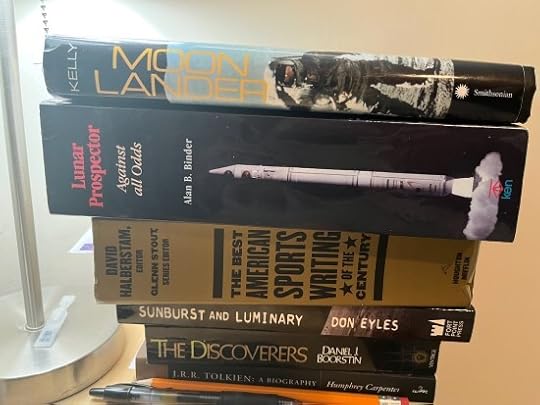 My current stack of nightstand books.
My current stack of nightstand books.I think that should keep my plate full while I wait for some of these other books to arrive.
Did you enjoy this post?
If so, consider subscribing to the blog using the form below or clicking on the button below to follow the blog. And consider telling a friend about it. Already a reader or subscriber to the blog? Thanks for reading!
March 11, 2025
That Which Moves You
My notions of art were formed during high school. Three years of art history as part of a core of humanities classes made me something of an art snob. We memorized paintings and artists the way chemistry students memorize elements and atomic weights1. It took decades to shake the snobbery, decades to go from “beauty is in the eye of the beholder” to “art is that which moves you.”
And since just about anything can move someone, just about anything can be art. I have read within the depths of a scientific paper, a sentence that moved me. That sentence was art. I have sat through a Sunday mass with a mediocre choir, only to hear a few perfect notes from a violin added to the performance—those notes lifting the whole thing to the level of art. I have seen elegant computer code that made me pause in wonder and admiration, something I imagine akin to elegance in mathematics or a brilliant chess move. All of them moving, all of them art.
I was thinking of this because of two recent performances I saw. The first was a high school performance of Stephen Sondheim’s “Into the Woods.” My son, no longer the little man, had the role of the Wolf. He’d been doing community theater for a few years now, but this was his first musical. He’d also been taking voice lessons. I’d never heard him sing until the night of the performance. I was blown away. I sat slack-jawed in the darkness as he sang, took choreographed steps, performed, became his character, creepily following Little Red Riding Hood on a stroll through the woods. In fact, it was not only his performance but the entire 2-1/2 hour performance, the actors, the musicians in the live orchestra, the perfect timing of the special effects, all of it moving me. It did not seem like a high school performance but something you’d see on a bigger stage. There was a level of professionalism and confidence that transcended the age of the performers. The art snob of my youth had seen performances of The Phantom of the Opera in Los Angeles. I’d seen performances of Les Mis; I’d seen a wonderful performance of Henry V at Shakespeare in the Park. I had never been more moved by the performing arts than when I sat in stunned silence, watching high school students perform Into the Woods.
This weekend, I went with my wife and mother-in-law to see The High Kings play at the Birchmere. This was my second time seeing The High Kings perform. My mother-in-law has become something of a groupie of this Irish band. I like both the band and the venue. Like the first time I saw them, we got seats at a table right at the foot of the stage. Unlike the first time I saw the band, this time, they had an opening act—two really—Mary Black, and opening for Mary Black was Róisín O—who turned out to be her daughter.
 The High Kings on Friday night.
The High Kings on Friday night.Róisín O did a short, 4-song set, but did it in an incredibly clever way that told a story without seeming to tell a story. Sometimes it is hard to know if art moves you, but this wasn’t one of those times. Even after her first song, I could feel tears streaming down my cheeks, hard to reach tears because of my glasses. What an incredible voice she has, strong clear, pitch-perfect. I was sad to see her leave after such a short set2.
Mary Black performed 10 songs, after which the High Kings took the stage. Their secret sauce is their harmonizing. It is incredible, especially when they are just three feet in front of you. It helps, too, that they play well, have great songs, and occasionally fall back on a traditional favorite. Perhaps because of the opening acts, they played a shorter set than the last time I saw them.
It had been a long day. It had been a long week. I was tired as we approached show time. But these artists and the art they created on stage revitalized me. And it moved me.
Isn’t that what art is really about?
I was going to say elements and their discoverers, to maintain parallelism, but the sad fact is that in all my chemistry classes in high school and college, I never once learned the name of a scientist who discovered an element. I had to wait a few years for Isaac Asimov to teach me that. ︎But delighted when she returned to the stage at the very end for a group encore.
︎But delighted when she returned to the stage at the very end for a group encore.  ︎
︎Did you enjoy this post?
If so, consider subscribing to the blog using the form below or clicking on the button below to follow the blog. And consider telling a friend about it. Already a reader or subscriber to the blog? Thanks for reading!
March 9, 2025
Shelf-Life #4: The Making of the Atomic Bomb
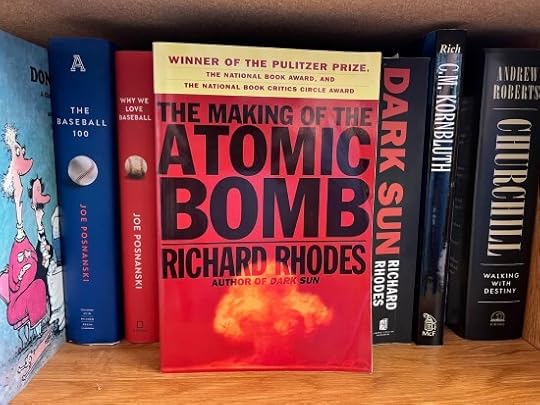
One of the traits that made Isaac Asimov a great explainer was his ability to start at the very beginning and tell a good story. The more complex a topic, the more important it is to begin with the basics and work your way up. Once asked to write a book on black holes, Isaac Asimov started at the beginning and didn’t get to black holes until the final chapter. (The book was The Collapsing Universe.) Asimov’s general science writing set a high bar for me when I read other science writing.
That bar was first exceeded, in my experience, when I read The Making of the Atomic Bomb by Richard Rhodes. To this day, I have not encountered a more perfect book on science, its methods and development, and its impact on society. The book has influenced me in several important ways. I’ve read it three times, and as I write this, I am reading it once again.
I read the book for the first time late in 2003. In subsequent readings, each one better than the one before, I began to see what Rhodes was doing in the book that made it such a good history of science—and a deserving winner of the Pulitzer Prize for General Nonfiction in 1988.
Rhodes seemed to embody Asimov’s notion of starting at the beginning. In the first part of the book, he introduces the key players in developing the science that would lead to the chain reaction that powers atomic weapons. We learn about the scientists as people exploring, asking questions, challenging assumptions. In doing this, Rhodes simultaneously provides a course in the sciences involved, similarly starting from basic principles and building them up. He subtly weaves yet a third strand through this web, one that explores developments in weapons of war, beginning with the Great War, in which poison gases were used, where bombs were dropped from airplanes, and where machine guns were prominent weapons of mass destruction, and considers the morality of such weapons. All three threads foreshadow what is to come as the world once again faces war and the notion of a new weapon of mass destruction becomes a reality. Scientists, scientific methods, historical context and the morality of the use of these terrible weapons and their effects on their victims and their inventors are the major themes of the book.
It is not surprising that a book like this would capture my imagination. I am intrigued by smart people engaged in massive projects that involve hard work. I’m not talking just about scientific efforts. Reading Will and Ariel Durant’s 11-volume Story of Civilization, a work that took a lifetime to produce, made me naturally curious about the people who put in the effort to bring it to fruition. It was not just the wonder of the Apollo program that captivated me, but also the stories of the people and efforts made to bring it to fruition.
Then, too, I don’t think most general science show how the scientific method works in practice. Rhodes did a wonderful job of this throughout the book. We get to see how theoretical and practical scientists and engineers work together to turn theory into practice. It makes the idea of a scientist less abstract. I would recommend this book to any high schooler interested in knowing what it is really like to be a scientist.
This book also had a direct impact on my day-to-day working life. When I first read the book, I’d been working in software development for a decade. A big part of my work involved making software, but I’d also started to transition into managing software projects. Just as no one taught me how to write code or structure software, no one taught me how to manage projects either. These were not huge efforts, but they were big for me, and I was constantly looking for ways to wrap my head around everything going on. I did some rudimentary project management training and was introduced to the concept of PMPs, but these courses always seemed abstract. I read books on project management theory, but those, too, were abstract. Reading about the Manhattan Project, however, gave me an idea of how a large project was run. Of course, this was one of the largest engineering projects of all time, and the projects I was working on were insignificantly small in comparison. But I found some ideas that carried over from one to the other.
Moreover, I was impressed that a massive project like this was accomplished without the need for software like Microsoft Project and similar tools. The planning was essentially done on paper. Later, as I read books on the Apollo program, particularly Thomas J. Kelly’s Moon Lander, I was further impressed by the management given the tools they had at their disposal. I suspect folks working on either of these projects would initially be envious of software that helps the planning process but would quickly find that too much time was spent getting the software to work, and not enough time was spent on actual planning.
Over the years, I’ve found that three books make up an unconventional course in project management. The Making of the Atomic Bomb was the first and the most influential of these. It also remains a model of the ideal way in which to tell the story of science and engineering in an engaging style. I wish more science books were written like this one.
Did you enjoy this post?
If so, consider subscribing to the blog using the form below or clicking on the button below to follow the blog. And consider telling a friend about it. Already a reader or subscriber to the blog? Thanks for reading!
March 7, 2025
A Dry Well
Photo by ArtHouse Studio on Pexels.com
" data-medium-file="https://i0.wp.com/jamierubin.net/wp-c..." data-large-file="https://i0.wp.com/jamierubin.net/wp-c..." src="https://i0.wp.com/jamierubin.net/wp-c..." alt="famous deep well of quinta da regaleira" class="wp-image-26087" srcset="https://i0.wp.com/jamierubin.net/wp-c... 975w, https://i0.wp.com/jamierubin.net/wp-c... 400w, https://i0.wp.com/jamierubin.net/wp-c... 550w, https://i0.wp.com/jamierubin.net/wp-c... 768w, https://i0.wp.com/jamierubin.net/wp-c... 900w, https://i0.wp.com/jamierubin.net/wp-c... 600w, https://i0.wp.com/jamierubin.net/wp-c... 450w, https://i0.wp.com/jamierubin.net/wp-c... 300w, https://i0.wp.com/jamierubin.net/wp-c... 150w" sizes="(max-width: 900px) 100vw, 900px" />Photo by ArtHouse Studio on Pexels.comThere are some days that start with meetings early in the morning and end with meetings late into the evening. This entire week has been like that, so I hope you will forgive me if I don’t have something prepared for the blog today. My brain is worn out. Fortunately, I have a new Shelf-Life post coming on Sunday for a book I really like. In the meantime, there is plenty here to read. If you’re looking for some recommendations, check out the curated index to the blog, which has some of my personal favorites.
Don’t tell anyone, but as of this moment, there are no meetings on my calendar today so I may get some work done. And later this evening, I’m going to see The High Kings in concert.
Happy Friday!
Did you enjoy this post?
If so, consider subscribing to the blog using the form below or clicking on the button below to follow the blog. And consider telling a friend about it. Already a reader or subscriber to the blog? Thanks for reading!
March 6, 2025
I Can’t Stand It!
Roughly four years ago, I bought myself a sit-stand desk for my home office. Sitting is sedentary and standing is healthier, I was told. As I wrote at the time, “My idea was that I would stand whenever I was working, and sit when I am not working. Given that the former tends to be more than the latter (especially since I consider writing work), I would be standing more than I would be sitting.”
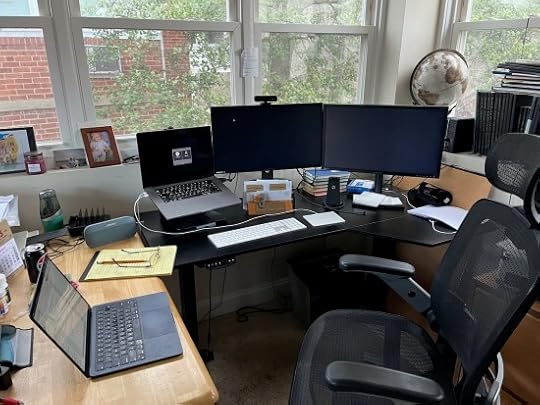 My standing desk, this morning.
My standing desk, this morning.The reality, much as I hate to admit it, is that after the first month or two, I’ve rarely stood at my desk. It quickly became obvious when my kids would ask, “Dad, how come you never stand at the desk?” Over the years, I considered many tricks: I would stand at my desk in the mornings. I would stand at my desk in the afternoons. I would stand during meetings (this latter means I’d often be standing 8 hours a day). None of it worked. Not even the idea that standing would improve my health and make me less sedentary. “Sedentary?” I’d tell myself, “I get out for a walk 2-1/2 twice a day. That’s not sedentary.”
Indeed, while walking this morning, I made a solemn promise to myself: First, that I would write a post about the first thing I saw when I returned to my office; second, that I would stand at my desk while writing it.
I was successful on the first point. My eyes caught sight of my desk as I stepped into the office, probably because I was keyed up about standing there to write. And so I wrote about my desk. However, I am notstanding as I write this. My laptop is sitting on my side-table, and I am sitting in my chair. My desk is sitting, too.
It is a terrible burden I bear, this guilt for not standing at my desk. I carry it through the day, as I attend virtual meetings and nearly everyone else I see on video is also not standing at their desks.
Did you enjoy this post?
If so, consider subscribing to the blog using the form below or clicking on the button below to follow the blog. And consider telling a friend about it. Already a reader or subscriber to the blog? Thanks for reading!



